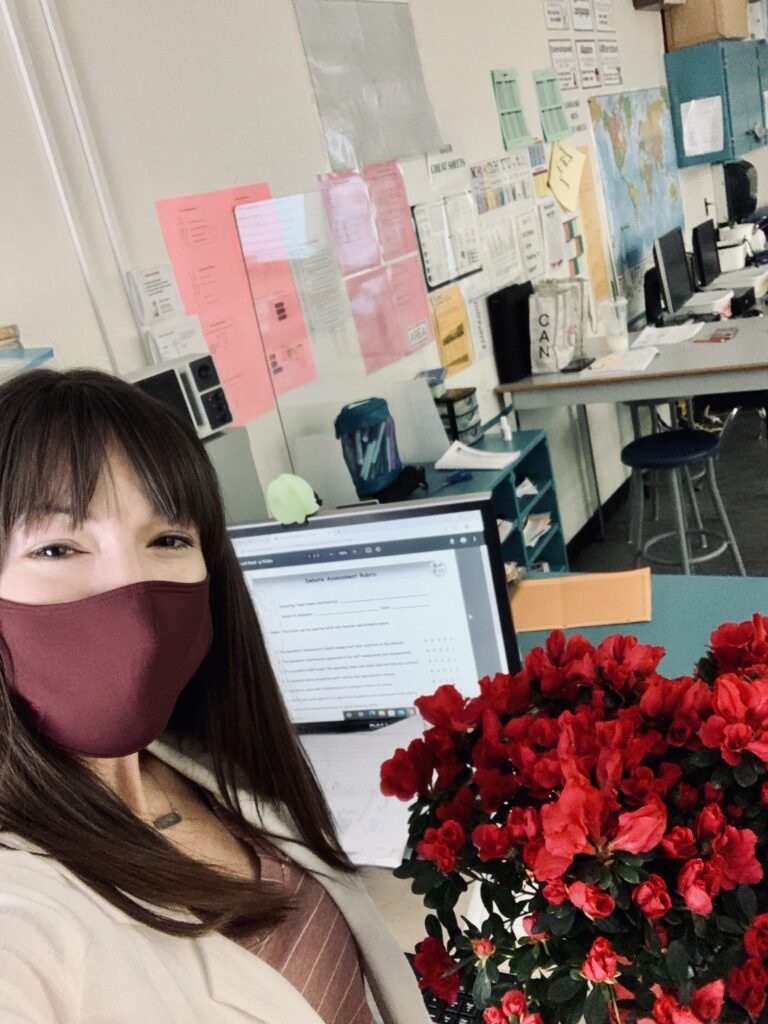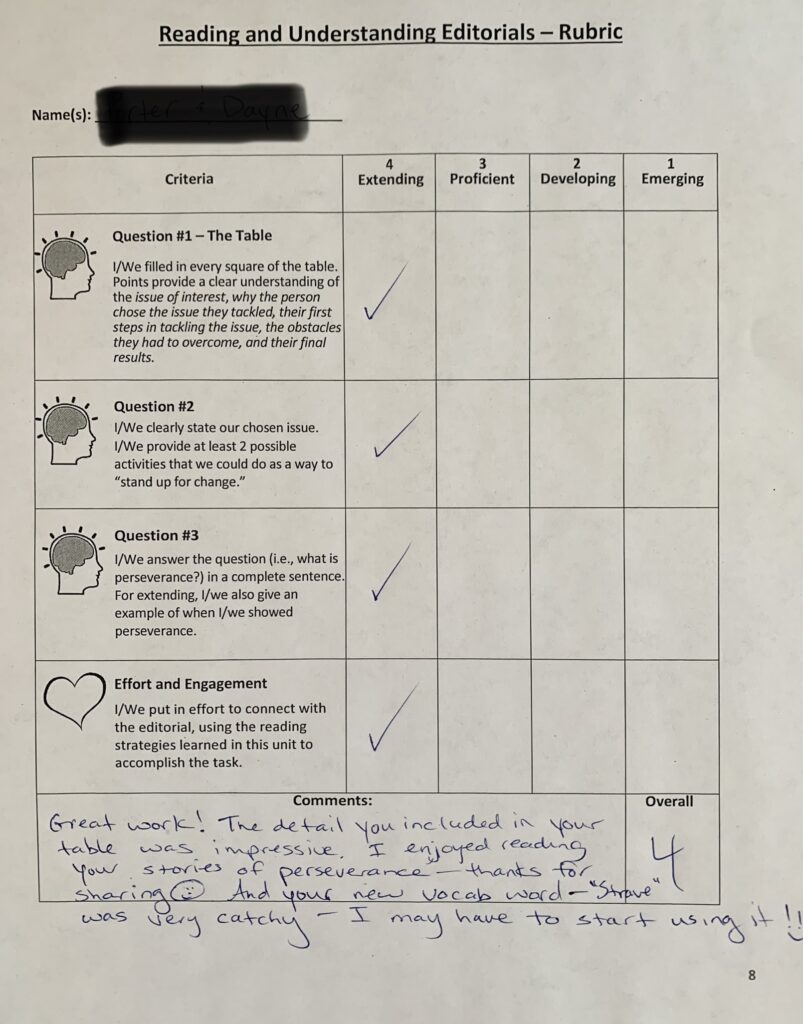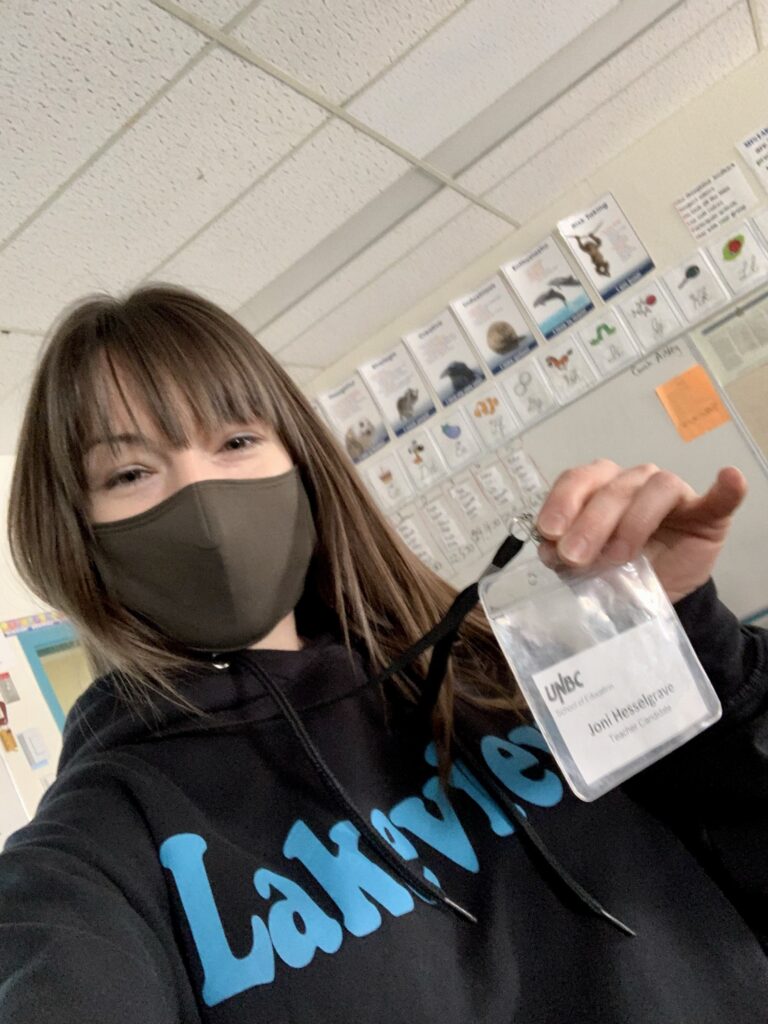
As teacher candidates, we were encouraged to approach this practicum with a sense of “playfulness”—to take chances, experiment, and try new things without fear of failure. Paraphrasing the words of Dr. Christina Younghusband: “This is your time to play! You can’t fail this practicum so try the idea, the tactic, or the lesson you’ve been wanting to try!” Hearing this and knowing that this practicum was just that—experiential, a chance for teacher candidates to gain experience and become more familiar with the role of the classroom teacher—relieved pressure and allowed us to experiment with instruction and assessment strategies that we may not have tried otherwise.
In designing, facilitating, and adjusting my lessons, I focused on how I could meet the needs of my diverse learners—those who were struggling (my developing and emerging learners), those who were “right on track” (my proficient learners), and those who were already masters (my extending learners). The pressing questions at the back of my mind—before, during, and after lessons—were: (1) how do I ensure that all my student “get it”? and (2) if they do not get it right away, how do I ensure that those not “getting it” receive the time and support they need to “get it” without slowing the pace of instruction to a rate where the proficient and extending learners become bored and disengaged?!? MY CT and I agreed that the best course of action was to provide as explicit instruction as possible at the outset, approaching the content as though students had never heard of it before. I broke concepts down to their most basic parts and then worked at putting them back together.

I ensured that instruction was engaging to all. I invoked students’ prior knowledge and connected it to new content. I ensured that my lessons were universally designed with all learners in mind and involved oral, visual, and written components. I drew upon technology (using the Smart Board to display visuals and audio-visuals) and gave students choice when it came to how they wanted to work and complete tasks (individually, in pairs, in small groups, or as a class). In most activities—whether during brainstorming and discussion tasks, reading comprehension tasks, written tasks, debate tasks, or math tasks—there was a reasonable level of choice. If a student (or students) struggled, I made sure to take a step back and re-teach and review before moving on. I offered levelled work and students had opportunities to self-assess their knowledge and skills before choosing “good fit” options that were challenging but not too difficult or frustrating.
I took all cues from my students and adjusted instruction, lessons, and tasks accordingly. I practiced, fostered, and honed my instructional agility—the “iterative process of understanding what you want students to learn, recognizing and interpreting student words and action, and responding in ways that build on students’ strengths, clear up misconceptions, and promote the next steps in their learning” (Erkens et. al., 2017, pg. 110). Although it was often a challenge juggling twenty-seven diverse learners in a single classroom, teachers must do this every day; those making it look easier than the rest have mastered instructional agility. My instructional agility hinged on assessment, and I tried several “new to me” assessment strategies during this practicum, including exit tickets for formative assessment and rubrics for summative assessment (one I made myself and one I adopted from an online source). Prior to this teacher education program, I had never heard of the “exit ticket” (never mind incorporated one into my teaching) and what I knew of rubrics was limited. Teaching on call and in part-time/short-term teaching vacancies has limited the assessment decisions I have had to make. Essentially, I have carried out assessment plans left by classroom teachers or continued to do what the permanent/contract teachers did (keeping classroom disruptions minimal).
But here, in this experiential practicum, I was given “free reign” to assess however I liked! It was both liberating and intimidating to be the sole decider of how to assess student learning. There were so many important decisions to make! How would I get students to demonstrate their learning or achieve the learning intention(s)? What would I assess and how would I assess it? Would my assessments be formative, summative, or both? What evidence would I gather? What tools would I use to help gather and assess? What type of feedback would I give (verbal, written, formal, informal)? How would I document and share assessment results? Would I incorporate opportunities for self-assessment, peer assessment or rely solely on teacher assessment? So many questions—questions I had not considered when assessment was the after-thought of a “fly-by-the-seat-of-my-pants/plan a day’s worth of lessons in the thirty minutes I have between the time I walk into the classroom and the time the morning bell rings” scenario, or when the lessons and assessments had been pre-ordained by the regular classroom teacher.
Initially, all the planning was challenging and the questions overwhelming. But, as the days went by, planning for assessment of learning became easier. Included below are excerpts from my lesson plans, each highlighting an assessment practice and/or strategy I planned and utilized during my practicum:
ELA Lesson 1: Introduction to Editorials – Students will achieve the learning intention by participating in a class discussion and watching the informational video. To invoke thinking and reflection, I will engage students with queries and prompts, and will provide formative feedback on their thoughts and ideas. At the end of the lesson, students will do an Exit Slip to demonstrate understanding. Students will be asked to write, on a sticky note or small piece of paper, something they envision seeing in an editorial that is of interest to them (i.e., basically any idea that involves an opinion or point of view that can be argued using facts/data/sources of information to persuade an audience toward an opinion or point of view). These exit slips will be discussed at the beginning of the next lesson.
ELA Lesson 2: Reading Editorials – Students will achieve the learning intentions by participating in class and group discussions. To invoke thinking and reflection, the teacher will engage students with queries and prompts, and will provide formative feedback on their thoughts and ideas. Students will work in small groups, where they will read, discuss, and answer questions about an editorial. Each group will share their answers with the rest of the class. During the sharing process, I will formatively assess student/group understanding and provide formative feedback in situ.
ELA Lesson 5: Reading Editorials Like a Writer – Students will achieve the learning intention by reading, discussing, and answering a selection of questions about an editorial (in pairs or small groups). The teacher will circulate the room during the read/respond portion of the lesson and provide formative feedback to students on their thoughts and ideas. Each pair/small group will turn in their written responses, which I will assess against a simple rubric (attached) and return with summative feedback, meant to guide further learning.
ELA Lesson 6: Introduction to Debate – Students will achieve the learning intention by participating in a class discussion and by planning and participating in a debate. I will circulate the room during the collaboration and planning process, providing formative feedback to students (i.e., on their opinions/points of view, arguments, evidence, opening statements, rebuttals, and closing statements). Students will then take turns debating. The audience will decide the winner of each debate by majority vote; that is, after each debate, I will ask the class which individual or team was the most convincing/persuasive? The audience will raise a hand for Individual/Team A or Individual/Team B. Then, we will give individuals/teams constructive feedback (2 strengths & 1 stretch), aimed at helping students improve for tomorrow’s debate.
ELA Lesson 7: Debating Issues That Matter to Us – Students will achieve the learning intention by planning and participating in a second, more serious, debate. I will circulate the room during the collaboration and planning process, providing formative feedback to students on their opinions/points of view, arguments, evidence, opening statements, rebuttals, and closing statements. Students will then take turns debating. The audience will decide the winner of each debate (majority vote). After each debate, I will ask the class which individual, or team, was the most convincing/compelling/persuasive? The audience will raise a hand for Individual/Team A or Individual/Team B. I will also assess students’ debate skills against a simple rubric which will be returned to them with summative feedback (meant to guide future debates).
Math Lesson 1: Equivalent Fractions – Students will demonstrate their learning and understanding of Equivalent Fractions and Fractions in Simplest Form in several ways: (1) in the responses they provide during “Discussion Time”; (2) in the responses they provide on individual whiteboards during “Show Me What You Know”; (3) in the responses they provide during a self-assessed thumbs up/down “Rate Your Understanding” poll; and (4) in their responses to questions during “Time to Practice.” Students will receive formative feedback at each of these four stages of learning. Student responses to the practice questions will be handed in at the end of the lesson/block so that I can review and provide feedback to students on where they are at in their learning (vs. where they need to be) before the next lesson. This way, I can adjust my instruction, reviewing and/or re-teaching when necessary. I can also arrange additional support and go over corrections (working toward mastery of the concept). Throughout the week (in lessons to follow), students will have ample opportunity to practice, gain teacher feedback, and receive extra support. At the end of the week (see Friday’s lesson plan), students will have a low-stakes, summative quiz to assess understanding of the concepts. Quiz results will help me determine if students need further instruction and review of the concepts, or if they are ready to move to new concepts (of increasing difficulty).
The lesson planning for this practicum was extensive, but all the planning paid off when I knew exactly what I was assessing before my lessons began! Teaching is so much easier when you know what you are assessing and why. Having an assessment plan and knowing how my assessment criteria connected to the curriculum, allowed me to tailor my lessons and adjust and adapt my instruction to meet the needs of the students—it helped me be instructionally agile.
During my practicum, my coaching teacher (CT) commended me on my ability to adjust my lessons and tasks as needed, based on the feedback I received from her and the students directly (in our conversation/discussions, in thumbs up/down polls, in their exit ticket responses and responses to assigned questions and practice problems, and on their quizzes) and indirectly (students’ ability to focus and engage with the instruction and assigned tasks). She was equally pleased with my ability to provide students with clear and concise feedback (verbally/formatively and written/summatively) that would guide their learning (taking them from where they were to where they needed to be) and with my ability to track and record evidence of student learning.
My assessment efforts helped me recognize early on that I needed to offer students levelled math options so that all had “good-fit” problems that were challenging but not too difficult. Students were given the opportunity to reach proficiency and show extending knowledge on low-stake summative quizzes based on what they practiced each week (working toward mastery at different levels). During my second week, I postponed adding a new concept as originally planned, choosing to spend more time working toward mastery before adding another, more challenging step. This decision paid off: students were successful having had the extra time and were ready for the new material when I introduced it at the beginning of my third week. My planned assessment efforts also enabled me to ensure students understood the criteria and knew what they were being assessed on prior to starting each task. Rubrics were shared during explicit instruction so there were no assessment surprises for anyone involved. I also paid attention to student feedback and showed flexibility when students required longer than expected to complete learning tasks (i.e., reading comprehension questions, group work, debating tasks, etc.). Formative feedback was provided to students verbally during every lesson and in writing on preliminary/practice questions. Summative feedback was provided on summative tasks (i.e., quizzes and end-of-unit tasks; see ELA rubrics below).


Upon reflection, I am proud of the instruction I provided and of the assessment and motivation strategies I utilized in my experiential practicum. I must say, after all of this planning and attention to detail, it is going to be hard to transition back to my TTOC role and not knowing my instruction and assessment plans in advance!!



